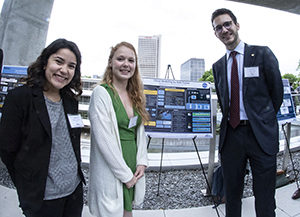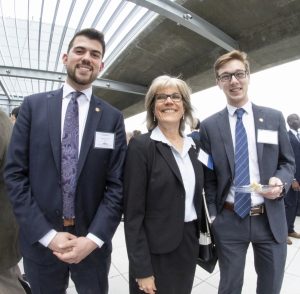
Ready to ASSIST. Lt. Col. Steven Chetcuti, left is seen here with two of his colleagues who worked on the ASSIST Project for Rolls Royce and the Australian Government. Chetcuti is a doctoral student in the ASDL. View more event photos
The first day of the ASDL's two-day External Advisory Board meeting was dominated by problem solving - and some possible job offers - as industry and government sponsors gathered to hear 17 teams of students present the results of their year-long "Grand Challenge" research. Another nine teams were scheduled to present on the second day.
But sponsors like Boeing, NASA, Aerospace Corporation, and Lockheed Martin did not wait for a second day of presentations to deliver their verdicts.
 ASDL Students Angelica Acevedo, Mannon Huguenin, Gabriel Achour
ASDL Students Angelica Acevedo, Mannon Huguenin, Gabriel Achour"I plan on handing out a lot of my business cards to each of you," said Jody Singer, the deputy director of the NASA Marshall Space Flight Center. "What you did today, presenting your work, was incredible. You definitely have the communications tools that will drive this field in the future."
Singer was one of many who praised the teams' technical and communications skills, showcased during nine hours of 40-minute research presentations, all of which focused on system-of-system challenges. A second day of presentations on vehicle design challenges had to be scheduled to accommodate a burgeoning interest in the Grand Challenge program.
"We were a little overwhelmed by how many sponsors wanted to work with our teams," said Dr. Katie Schwartz, a research engineer who works with ASDL director Dr. Dimitri Mavris to produce the year-long challenge. "There are some sponsors that have been ongoing, year to year, because there continue to be fresh approaches to pursue. But this year, there were new sponsors with new questions."
 Skunkworks engineer Beverly Baughman, center, was one
Skunkworks engineer Beverly Baughman, center, was oneof many industry visitors who were impressed with the ASDL presentations
Answering one of this year's challenges was Team ASSIST - the Asset Selection and Simulation for Intra-theater Support Tool - which brought together seven ASDL graduate students to address manufacturing and technology issues faced by Rolls Royce and its client, the Australian Government's Department of Defense.
"We developed a trade space analysis to enable asset acquisition that meets the needs of both the manufacturer - Rolls Royce - and the end user - the Australian Army," said ASDL doctoral student Steven Chetcuti, a West Point grad who currently serves as a lieutenant colonel in the United States Army.
"Rolls Royce wants to invest in engines that meet the needs for autonomy, but they also have to know how effective those assets are -- how they need to be improved to be in demand. Our job was to facilitate the investigation, evaluation and communication. There needs to be targetable performance metrics that meet the needs and capacities of both."
A lively discussion of the student poster presentations dominated the EAB Reception, Wednesday night.
Their challenge boiled down to the creation of a flexible environment where new technologies could be rapidly compared and evaluated.
 |
"We broke the problem down by simulating a human aid disaster scenario that had just enough stochastic variables to encompass the unpredictability of real-world demands," said Chetcuti.
While their findings have not yet been implemented, they are not 'all theory.' The parameters of their assignment made some real-world demands on the engineers. Their results had be operational by 2030, demonstrate marked improvement for both manufacturer and customer, and be highly economic.
The laser focus that Chetcuti and other student researchers applied to their problems prompted ripples of admiration from the very accomplished engineers and decision-makers who make up the External Advisory Board.
"The credibility is a given. This is Georgia Tech, so we know they have deep discipline knowledge," said Mark Rogers, manager of the Engineering Directorate's Advance Concepts Office at NASA's Marshall Space Flight Center. "What makes these students stand out is their grasp of system thinking and their ability to communicate it."
Like many in attendance, Jimmy Kenyon graduated from ASDL. But the executive director of Pratt & Whitney's Advanced Programs and Technology division wasn't inclined to give his alma mater a break. He was genuinely impressed.
"I've given my [business] card to a number of students whom it would be nice to see with a Pratt & Whitney badge," he said. "The students I heard today have a unique skill set. The are able to express technical ideas very clearly, to actually tell the story, which is very difficult when it's a deeply technical field."

This is what nextgen engineers look like. After presenting their research for nine hours, the students involved in the ASDL's Grand Challenge Program, listened to the feedback -- and some hinted job offers -- from the industry titans in the audience.